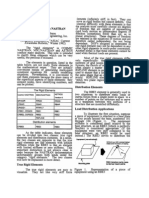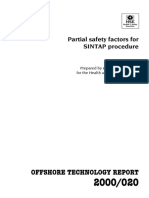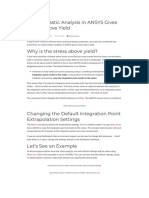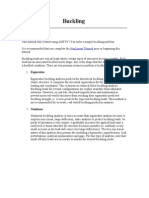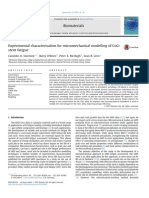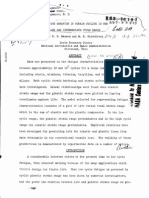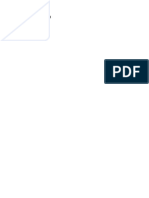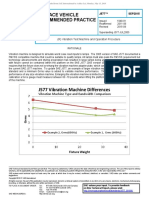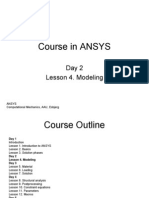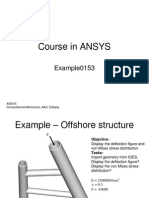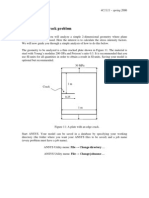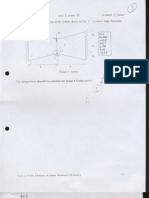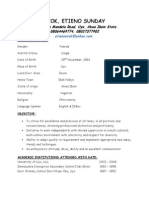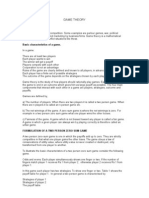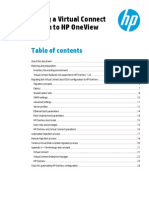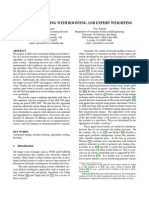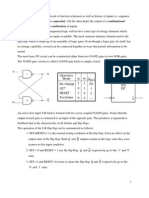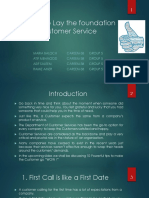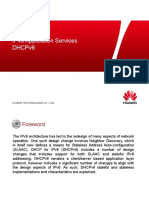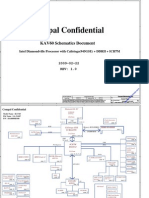The Finite Element Method
General Meshing Guidelines and Accuracy
ANSYS Computational Mechanics, AAU, Esbjerg
�General Considerations in Meshing
When choosing elements and creating meshes for FEA problems users must make sure that Chosen mesh size and density are optimal for the problem (to save computational time) Chosen element types are appropriate for the analysis type performed (for accuracy) Element shapes do not result in near singular stiffness matrices Chosen elements and meshes can represent force distributions properly
ANSYS Computational Mechanics, AAU, Esbjerg Meshing rules 2
�Symmetry
One of the most powerful means of reducing the size of a FEA problem is the exploitation of symmetry Symmetry is said to exist if there is a complete symmetry of geometry, loads and constraints about a line or plane of symmetry When exploiting symmetry model needs to be modified to replace the line or plane of symmetry without affecting the results
ANSYS Computational Mechanics, AAU, Esbjerg Meshing rules 3
�Symmetry (contd)
An simple case of complete symmetry
Constraints corresponding to lines of symmetry (LOS) do not allow displacements perpendicular to the LOS
ANSYS Computational Mechanics, AAU, Esbjerg Meshing rules 4
�Symmetry (contd)
Similarly
ANSYS Computational Mechanics, AAU, Esbjerg
Meshing rules
�Symmetry (contd)
There is no symmetry in this case
F
ANSYS Computational Mechanics, AAU, Esbjerg Meshing rules 6
�Symmetry Meshing Rules
Nodes must be placed on lines or planes of symmetry In 2D nodes on lines of symmetry (LOS) must be constrained to have zero displacements perpendicular to LOS; no rotational constraints on LOS (in-plane) In 3D nodes on the plane of symmetry (POS) must be constrained to have zero displacements out of the POS; no in-plane rotational constraints on POS
ANSYS Computational Mechanics, AAU, Esbjerg Meshing rules 7
�Antisymmetry
Sometimes the loading or boundary conditions may be such that antisymmetry exists
ANSYS Computational Mechanics, AAU, Esbjerg
Meshing rules
�Antisymmetry (contd)
Consider the simple antisymmetry case below
z = 0
z = 0
Constraints corresponding to lines of antisymmetry (LOAS) do not allow displacements along the LOAS or any rotational displacements
ANSYS Computational Mechanics, AAU, Esbjerg Meshing rules 9
�Antisymmetry Meshing Rules
Nodes must be placed on lines or planes of antisymmetry In 2D nodes on lines of antisymmetry (LOAS) must be constrained to have zero translational and rotational displacements along (in-plane) LOAS In 3D nodes on the plane of antisymmetry (POAS) must be constrained to have zero inplane translational and rotational displacements
ANSYS Computational Mechanics, AAU, Esbjerg Meshing rules 10
�Symmetry/Antisymmetry in ANSYS
ANSYS supports symmetry and antisymmetry constraint sets
ANSYS Computational Mechanics, AAU, Esbjerg
Meshing rules
11
�Discontinuities
Nodes must always be placed at locations where geometry, loads, or boundary conditions change abruptly (discontinuities)
Concentrated load Abrupt change in load Abrupt change in geometry
Abrupt change in support
ANSYS Computational Mechanics, AAU, Esbjerg Meshing rules 12
�Correct Choice of Elements
Choose element types that are appropriate for the loading and stress conditions of the problem Make sure that the elements chosen capture all possible significant stresses that may result from the given loading, geometry, and boundary conditions
Slender beam; beam elements
Thick beam (shear present); quadrilateral plane stress or plane strain elements
ANSYS Computational Mechanics, AAU, Esbjerg Meshing rules 13
�Aspect Ratio
For a good mesh all elements must have a low aspect ratio Specifically
b h
b 24 h
where b and h are the longest and the shortest sides of an element, respectively
ANSYS Computational Mechanics, AAU, Esbjerg Meshing rules 14
�Element Shape
Angles between element sides must not approach 0 or 180
Worse
Better
ANSYS Computational Mechanics, AAU, Esbjerg
Meshing rules
15
�Mesh Refinement
Finer meshing must be used in regions of expected high stress gradients (usually occur at discontinuities)
Discontinuities
ANSYS Computational Mechanics, AAU, Esbjerg
Meshing rules
16
�Mesh Refinement (contd)
Mesh refinement must be gradual with adjacent elements of not too dissimilar size Mesh refinement must balance accuracy with problem size ANSYS provides various tools for mesh refinement such as refinement at nodes, elements, lines, and volumes
ANSYS Computational Mechanics, AAU, Esbjerg Meshing rules 17
�Dissimilar Element Types
In general different types of elements with different DOF at their nodes should not share global DOF (for example do not use a 3D beam element in conjunction with plane stress elements) ANSYS allows certain classes of different element types to share nodes (e.g. spar and beam elements) but element and meshing guidelines must always be consulted before attempting to combine dissimilar element types
ANSYS Computational Mechanics, AAU, Esbjerg Meshing rules 18
�Equilibrium and Compatibility
The approximations and discretizations generated by the FE method enforce some equilibrium and compatibility conditions but not others Equilibrium of nodal forces and moments is always satisfied because of
KU = F
Compatibility is guaranteed at the nodes because of the way K is formed; i.e. the displacements of shared nodes on two elements are the same in the global frame in which the elements are assembled
ANSYS Computational Mechanics, AAU, Esbjerg Meshing rules 19
�Equilibrium-Compatibility (contd)
Equilibrium is usually not satisfied across interelement boundaries; however discrepancies decline with mesh refinement
( ( x1) x2 ) ( ( y1) y2 )
(1 (2 xy) xy )
along this boundary Stresses at shared nodes are typically averaged over the elements sharing the node
ANSYS Computational Mechanics, AAU, Esbjerg Meshing rules
ANSYS uses stress disparities at nodes as a measure of discretization error
20
�Equilibrium-Compatibility (contd)
Stresses are most reliable near the centers of elements and least reliable near their edges Compatibility may not be satisfied across interelement boundaries (happens with certain types of higher-order elements and junctures of dissimilar elements); incompatibilities decline with mesh refinement
Lower-order element Higher-order element
gap
ANSYS Computational Mechanics, AAU, Esbjerg Meshing rules 21
�Equilibrium-Compatibility (contd)
Equilibrium is usually not satisfied within elements because KU = F does not enforce the relations produced by the partial differential equations that define equilibrium at infinitesimal levels; the assumed displacement functions that led to KU = F only satisfy kinematic boundary conditions, not the differential equations themselves Compatibility is satisfied within elements (guaranteed by the choice of continuous and single valued displacement functions)
ANSYS Computational Mechanics, AAU, Esbjerg
Meshing rules
22
�Example: Plate with Crack
Model the thin aluminum plate shown below using symmetry and refine mesh in regions where the discretization error is large 1
2
2
5
10,000 psi
10
ANSYS Computational Mechanics, AAU, Esbjerg Meshing rules 23
�Example (contd)
Modeling only the right half of the plate, using PLANE42 elements and applying symmetry boundary conditions we obtain the following stress ( x ) distribution in ANSYS
ANSYS Computational Mechanics, AAU, Esbjerg
Meshing rules
24
�Example (contd)
To see the discretization error in ANSYS we plot the variable SDSG (from Error Estimation in Element Solution)
ANSYS Computational Mechanics, AAU, Esbjerg
Meshing rules
25
�Example (contd)
Clearly (and as expected) the worst error occurs around the crack meaning that the elements in that region need to be modified Contour plots of the same stress distribution and discretization error estimate are shown in the next page with a model that includes (Level 3) refined elements around the crack The refined models exhibit smoother distribution of stress with lower error estimates
ANSYS Computational Mechanics, AAU, Esbjerg
Meshing rules
26
�Example (contd)
ANSYS Computational Mechanics, AAU, Esbjerg
Meshing rules
27
�Example (contd)
ANSYS Computational Mechanics, AAU, Esbjerg
Meshing rules
28








